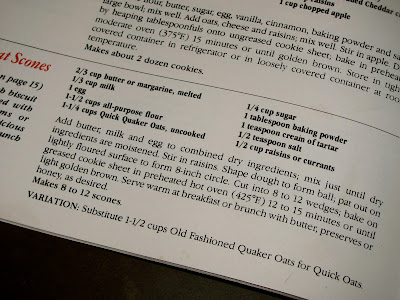Some time ago, decades actually, my uncle Dominic did an uncharacteristic thing. He tore a free-offer coupon from one of his wife Laura's collectible supermarket cookbooks, scribbled his name and address in the appropriate areas, and mailed it off to the company whose promotion so captured his attention.
Weeks later The Quaker Oats Wholegrain Cookbook arrived in the mail. Just 64 pages long, a pamphlet really, it was crammed with all sorts of recipes employing both original and quick-cook Quaker Oats. Some of the recipes seemed innocent enough — Honey Oatmeal Muffins, Toasty Oat Pie Crust — while others may have stretched things just a bit too far — Corn and Frank Chowder, Mexicali Meat Loaves... Saucy Meatballs?
Of the 68 recipes printed between the covers of the little pamphlet, this is the one that caught my uncle's eye. It is found on page 20 and takes up barely half of the 5-by-8-inch space. So far as I know it is the only recipe my uncle showed any interest in. I have asked him many times about his cookbook and its Scottish Oat Scones — his Scottish Oat Scones — but I can't say that I have ever gotten to the bottom of Dominic's fascination with either.
My uncle has made these scones perhaps hundreds of times. Last year I went to visit him the day after a grueling session of chemotherapy had left him quite weakened, and there on the kitchen table was a pile of his freshly made scones. He had baked them at 2 a.m. because he was unable to sleep. And because, I would imagine, doing so made him feel more like himself than his sickness.
"It was free," he has said of the pamphlet he mailed away for, possibly as far back as 1979, when it was published. "What can I tell you. For some reason it interested me."
And the scones?
"They looked so simple to make," he tells me every time I probe the deeper meaning of the mysterious "Scottish" baked good that my Italian-American uncle decided to master. "I'm sorry, me lad. I wish I could be more help to you."
I love it when he calls me me lad.
Lately Dominic has not been feeling so well. We're all quite concerned about him. Just before the holidays he spent time in the hospital, and when he came out it was clear that he had weakened. The day before I drove down to visit I decided to try and whip up a batch of his scones and bring them to my uncle. I had never baked a scone before in my entire life and yet the idea of making them for the master did not concern me in the least.
If you knew my uncle you might understand why the thought of possibly botching his "world-famous" scones could not possibly have rattled me. Dominic has never practiced the art of being unkind. He is what was envisioned when the term gentleman was coined. I would be very happy to be half the man that he is. Or to display the tiniest portion of his warmth, generosity or humanity.
Which is a syrupy way of saying that I knew my uncle and I would have a fine laugh over my taking a crack at his scones. No matter how good or how bad they turned out to be.
The first thing Dominic said after laying eyes on the scones was that they looked beautiful, if a bit overdone.
"Aunt Laura won't let me cook them this way," he confided to me. "She doesn't like these dark spots, the crispy edges, you know? The color has to be very light, not dark like these here, otherwise she won't eat them."
Laura is the woman my uncle has slept beside for more than 66 years, and his careful attention to her comfort and pleasure in all matters is inspiring.
Dominic only managed a couple bites of a scone. He assured me that I had done a "very nice job," but that his appetite just wasn't very good. He apologized for not eating more, and I told him not to worry, they would keep for a few days. Still, I wondered if I had erred in forcing them upon him.
No man should be made to apologize for his affliction. Certainly not this man.
Last spring, on a routine visit to see how he was doing, Dominic handed me this note (click the pic to enlarge), accompanied by a 50-year-old gold wristwatch. The watch, a very fine Longines, had a brand new leather band. It was also just out of the shop for a complete cleaning and a minor repair, things my uncle had gotten done specifically in order to present the watch to me.
It was Dominic's own wristwatch. And now it is mine.
Like the man himself, an extraordinary gift that I will carry proudly until I am gone.
Oh, and here's the scone recipe. My uncle is right, they're a snap.
Just watch out for Aunt Laura's dark spots.














































